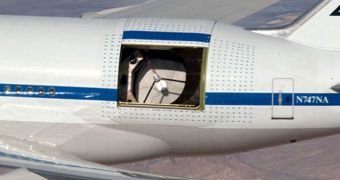The second segment of flight tests scheduled for the airborne SOFIA telescope have just concluded successfully, officials at the American space agency announce.
NASA officials say that the Stratospheric Observatory for Infrared Astronomy, which the agency developed with colleagues at the German Aerospace Center (DLR), performed exquisitely in the new batch of tests.
The heavily modified Boeing 747 SP aircraft that houses the observatory again flew with its lateral door opened, so as to allow light to enter the actual 2.5-meter main mirror SOFIA boasts.
With the new flights concluded, NASA has officially granted permission for the aircraft to conduct scientific observations from as high as 45,000 feet (roughly 13.700 meters), and from all observing elevations.
This was the second segment of flight envelope expansion tests, which NASA and DLR executed starting June 23. The tests added up to 49 flight hours, for a total of 12 flights.
Experts tracked a variety of factors during the experiments, including overall performance, handling qualities, and the structural characteristics of the aircraft.
The team managing the advanced aircraft is currently moving forward with the remaining tests, which are destined to identify and troubleshoot any potential problems that might arise in SOFIA's auxiliary systems.
For now, the scientists are content with having determined the most important features of the airframe, the acoustics of the telescope cavity, and the vibration levels that develop at the highest elevation angles.
All remaining tests are scheduled to be completed by the end of this year, and NASA announces that it currently targets an estimated 960 research flight hours per week.
According to the flight manifest the agency is working on, SOFIA will be airborne about three to four nights per week.
The project manager for the telescope is Brent Cobleigh, who is the director of the Exploration Systems Mission Directorate at NASA's Dryden Flight Research Center, in Edwards, California.
SOFIA carries nine instruments for conducting infrared studies at wavelengths from 1 to 655 micrometers, and high-speed optical studies at wavelengths from 0.3 to 1.1 micrometers.
Currently, the Boeing aircraft that houses the telescope is scheduled to fly for the next two decades, Space Fellowship reports. Follow me on Twitter @TudorVieru

 14 DAY TRIAL //
14 DAY TRIAL //